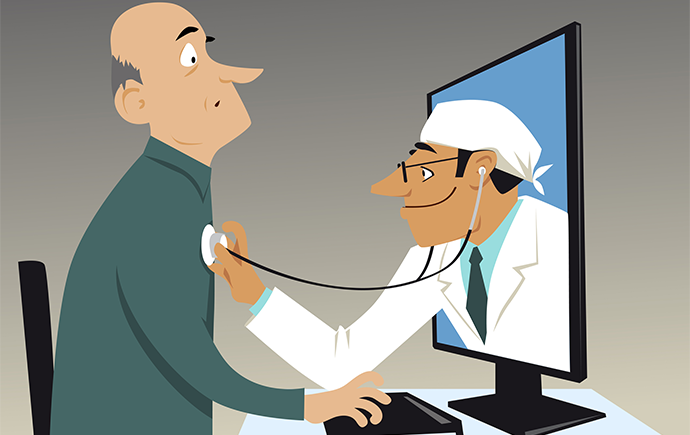Remote Patient Monitoring Offers More Than Just Population Health Benefits
For one Utah doctor, a remote patient monitoring platform is helping him and his staff make chronic care management more personal - and effective.

Source: ThinkStock
- Remote patient monitoring is an ideal strategy for large health systems looking to create an effective population health program – but it can also be a nice way for small practices and independent doctors to forge better care management practices with individual patients.
In rural Delta, UT, Alan Smith is using RPM to help about 160 patients with chronic care management needs. He’s the only one of the area’s four family physicians using the platform, which supplies mHealth devices to patients and allows him to keep tabs on selected biometric data.
“It’s a nice little way to focus on my patients and tighten up the loose ends,” he says.
Located on the western flanks of the Rockies along the Sevier River, Delta is a farming community of roughly 3,500, known for its Topaz Museum and the Millard County Fair. Provo lies about 90 miles to the north, with Salt Lake City roughly 40 miles beyond that, making access to specialists a bit difficult, especially during the winter months.
Roughly a year ago, Smith took a look at his patient population, and realized some of them needed better management for diabetes, heart disease, kidney disease and a host of other conditions that could use help in between the visits to his office. He focused on his Medicare population, particularly those over 65, who might not get around much, and for whom chronic care management was especially important.
READ MORE: A Small Medical Group Uses Telehealth to Redesign Care Management
Working with 100Plus, an RPM start-up launched by former Practice Fusion chief Ryan Howard, he identified patients most in need of RPM. The company offered to contact those patients, but he wanted to do the job himself, sending them letters and following up with phone calls.
“It really did help for me and my staff to personally reach out to them,” he says, noting that roughly 80 percent agreed to take part in the program.
Once the patients were identified, they were mailed preprogrammed devices within two weeks, with instructions on how to use the devices. Back at the practice, Smith and his staff set up a dashboard to keep track of the data coming in. Staff were taught how and when to check the dashboard, what to do when readings went above or below where they were supposed to be, and when to call in Smith for more immediate action. Staff typically review the data weekly, while he takes a look at the information every month, unless something comes up that requires more immediate attention.
Smith says the platform allows him and his staff to keep better track of weekly trends that may be affecting his patients’ health. But more importantly, his patients feel more secure knowing there’s someone they know who’s checking in on them regularly, through a telehealth connection.
“Remote patient monitoring is viewed as a population health pattern to save money,” he says. “There is an income advantage to that, but I want to focus more on my individual patients.”
READ MORE: Wellstar Uses Remote Patient Monitoring to Create Partnerships With Patients
Smith says he realized quickly that many patients with chronic care needs aren’t as diligent about their daily health routines as they should be, and they need subtle reminders to watch what they eat, get a little bit of exercise or take their medications. The idea isn’t to hover over their shoulder and tell them what to do, but to give them a nudge every now and then and help them when they need it.
“These are people I’ve known a long time,” says Smith, who’s been in practice for more than 30 years. “The thing that I have enjoyed in a small town like this is that the patients know me and my staff. Healthcare here is … personal and trustworthy.”
There have been the occasional glitches, as there always are with new programs. Some patients needed help learning how to use the technology, and some thought Ava – the bot used in the 100Plus platform for text messages and alerts – was a new member of Smith’s staff. It also took a while to integrate the new service into the office workflow to a point that Smith and his staff were comfortable.
“It took a while to get used to (the process), but we see where this can go,” Smith says. “The biggest problem we’ll have now is making sure patients don’t lose interest, or get busy and forget to do what they’re supposed to be doing.”
While it’s too early to show the success of the program, Smith says he’s seen “tremendous impacts” in patients who’ve long had problems keeping their weight, blood pressure or blood sugar under control. He says he’s found that the improvements are gradual.
READ MORE: Maine Home Health Program Uses Telehealth, RPM to Combat Loneliness
“The more a patient is involved in their healthcare, the healthier they will be,” he says. “So we see this as a way of getting them more involved. This has augmented my ability to take care of my patients dramatically … but it only works if they feel comfortable with it.”
Smith sees RPM as a platform on which value-based care will evolve, giving providers large and small more opportunities to collaborate with patients and move the needle on outcomes. He likes that this platform gives him and his staff what they need now to improve chronic care management, and he expects they’ll add more tools in the future to help more patients, including those needing mental health services.
“This is me getting to know my patients personally,” he says. “It’s what we’ve always tried to do, and this is helping us to do it better.”
